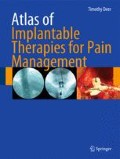Abstract
The placement of a lead into the epidural space is an accomplishment that is essential to performing spinal cord stimulation. Once the lead is in place, the clinician must program the device to deliver current to change the way the spine modulates neural signals. Each device manufacturer has significant intellectual property design that makes their programming unique. The goal of this chapter is to give a noncommercial look at general programming principles. The physician should have a good understanding of electrical properties that are critical in achieving an overall acceptable outcome. The first perception the physician must comprehend is the lead target for ideal stimulation (Table 9.1). The targets are a starting point for programming, but they may vary based on patient-specific anatomy. The basic concepts of programming involve the understanding of amplitude, pulse width, and frequency (Figure 9.1). Amplitude involves the intensity of the electrical field. Increasing the amplitude results in a change in the size of the electrical field. Pulse width is the length of time the nerve target is exposed to an impulse. Frequency is the number of exposures that occur per minute of stimulation.
Access this chapter
Tax calculation will be finalised at checkout
Purchases are for personal use only
Selected Reading
Falowski S, Celii A, Ashwini S. Spinal cord stimulation: an update. Neurotherapeutics. 2008;5:86–99.
Harke H, Gretenkort P, Ulrich H, et al. spinal cord stimulation in postherpetic neuralgia and in acute herpes zoster pain. Anesth Analg. 2002;94:694–700.
Krauss J, Weigel R, Blahak C, et al. Chronic spinal cord stimulation in medically intractable orthostatic tremor. J Neurol Neurosurg Psychiatry. 2006;77:1013–1016.
Kumar K, Hunter G, Demeria D. Spinal cord stimulation in treatment of chronic benign pain: challenges in treatment planning and present status, a 22-year experience. Neurosurgery. 2006;58(3):4812.
Schlaier P, Eichhammer B, Langguth C, et al. Effects of spinal cord stimulation on cortical excitability in patients with chronic neuropathic pain: a pilot study. Eur J Pain. 2007;11(8):863–868.
Author information
Authors and Affiliations
Corresponding author
Rights and permissions
Copyright information
© 2011 Springer Science+Business Media, LLC
About this chapter
Cite this chapter
Deer, T.R. (2011). Programming Spinal Cord Stimulation Systems. In: Atlas of Implantable Therapies for Pain Management. Springer, New York, NY. https://doi.org/10.1007/978-0-387-88567-4_9
Download citation
DOI: https://doi.org/10.1007/978-0-387-88567-4_9
Published:
Publisher Name: Springer, New York, NY
Print ISBN: 978-0-387-88566-7
Online ISBN: 978-0-387-88567-4
eBook Packages: MedicineMedicine (R0)

